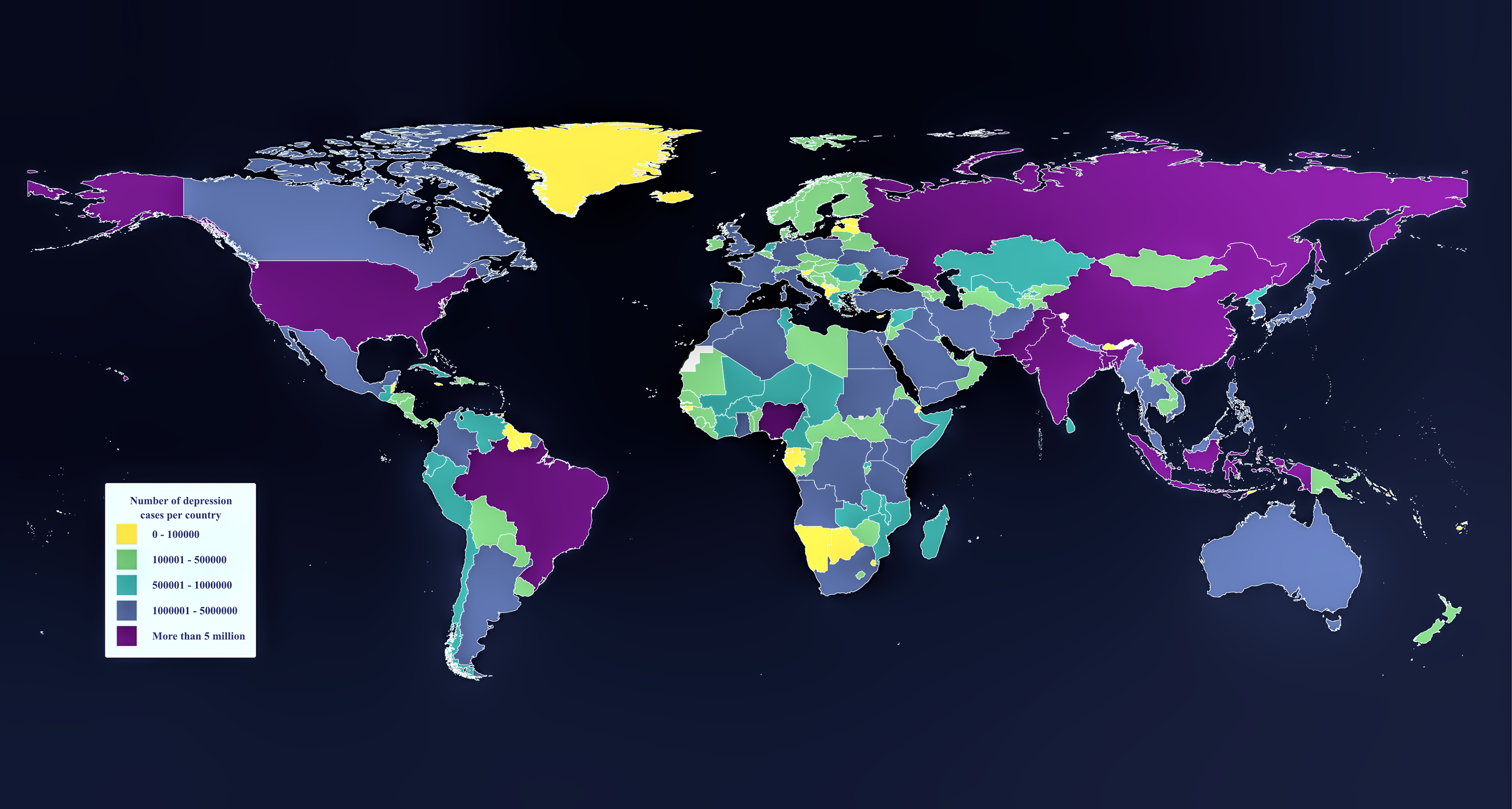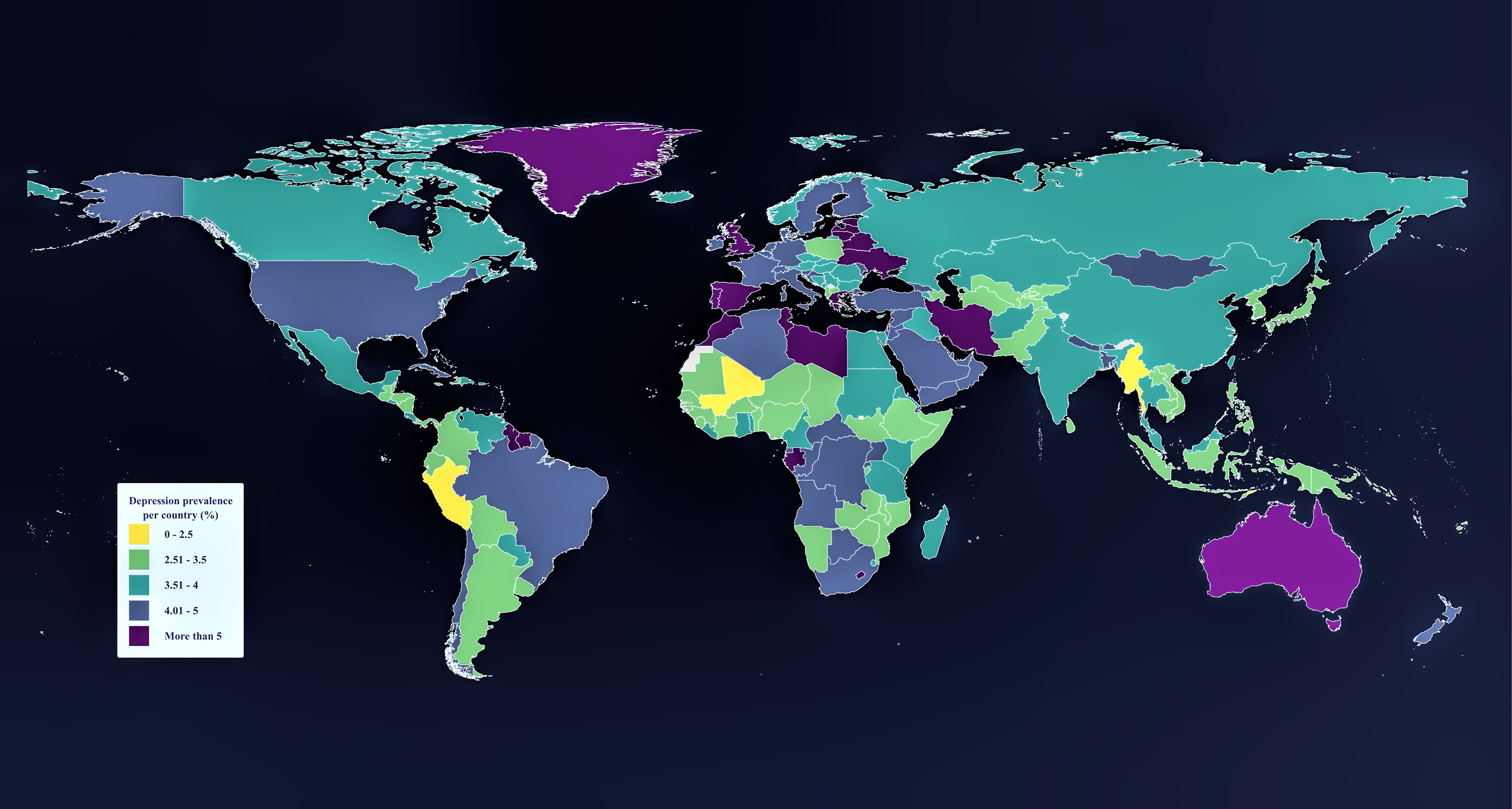MAPS OF DEPRESSION IN THE WORLD
Rodriguez, A., & Rodriguez, C.
2023
Although people, frequently, believe that others are always in good mood or happy, and only few individuals experience depressive symptoms, data tell us a very different story.
Worldwide statistics reveal that in several Asian countries, such as China, India, Pakistan, Indonesia, and Bangladesh there are more than 5 million citizens, per country, suffering from depression. This same registry can be observed in the United States, Brazil, Nigeria, and Russia (Figure 1).
Figure 1. Worldwide depression cases, per country, in 2019 (Source of data: Institute for Health Metrics and Evaluation [IHME], 2020; Data analysis and presentation performed by the authors).

Regardless of the amount of cases being influenced by the number of inhabitants in each country, depression prevalence per country shows that more than 1 out of 20 individuals can suffer from depression in several regions, including the Iberian Peninsula, Greenland, United Kingdom, Australia, Greece, and Iran, apart from some countries in Northern Africa and the east of Europe. Conversely, the number of countries where this prevalence did not reach 2.5% were scarce – Myanmar, Peru, Mali, Singapore, Timor-Leste, and Brunei (Figure 2).
Figure 2. Worldwide depression prevalence, per country, in 2019 (Source of data: IHME, 2020; Data analysis and presentation performed by the authors).

The statistics presented evidence trends observed in 2019, however, since then the numbers may have increased due to global events, such as the Covid-19 pandemic, or the start of war conflicts in several territories. Some of these places include Ukraine and Myanmar, the latter having under 2.5% depression prevalence in 2019. It is known that the lockdown and restricted social contact during the Covid-19 pandemic motivated a rise in depression cases. Older people could have been affected the most due to the limited access to social media and technology that would otherwise enable the communication with relatives and friends. The mentioned networks were widely used by other age-groups to maintain social bonding, in a period when people could not interact with others at work or socially, as they did before. This physical distance, thus intensified negative emotions related to social relationships and belonging, professional role and life uncertainty.
Geopolitical issues might be an important trigger for mental health problems, including depressive symptomatology (Chudzicka-Czupała et al., 2023). Countless citizens have seen their homes and cities shelled, losing their possessions, economic stability and friends, while living with a constant fear for their integrity and lives. However, due to the consequences of these conflicts, individuals are often unable to seek medical care, either because they cannot access healthcare facilities or the healthcare services are saturated and lacking both personnel and financial sustainability (Seleznova et al., 2023). Overall, the number of people affected by depression could be even higher, hence depressive disorder being a relevant mental health illness that deserves a closer monitoring and investment.
References٭
Chudzicka-Czupała, A., Hapon, N., Chiang, S.-K., Żywiołek-Szeja, M., Karamushka, L., Lee, C. T., Grabowski, D., Paliga, M., Rosenblat, J. D., Ho, R., McIntyre, R. S., & Chen, Y.-L. (2023). Depression, anxiety and post-traumatic stress during the 2022 Russo-Ukrainian war, a comparison between populations in Poland, Ukraine, and Taiwan. Scientific Reports, 13(1), 3602. https://doi.org/10.1038/s41598-023-28729-3
Institute for Health Metrics and Evaluation. (2020). Global burden of disease study 2019 (GBD 2019) results. https://vizhub.healthdata.org/gbd-results/?params=gbd-api-2019-public/3a2ecda73d8631fa9bb231a5ab17f035
Seleznova, V., Pinchuk, I., Feldman, I., Virchenko, V., Wang, B., & Skokauskas, N. (2023). The battle for mental well-being in Ukraine: Mental health crisis and economic aspects of mental services in wartime. International Journal of Mental Health Systems, 17(1), 28. https://doi.org/10.1186/s13033-023-00598-3
٭Please note that in the website references might not show the original format.